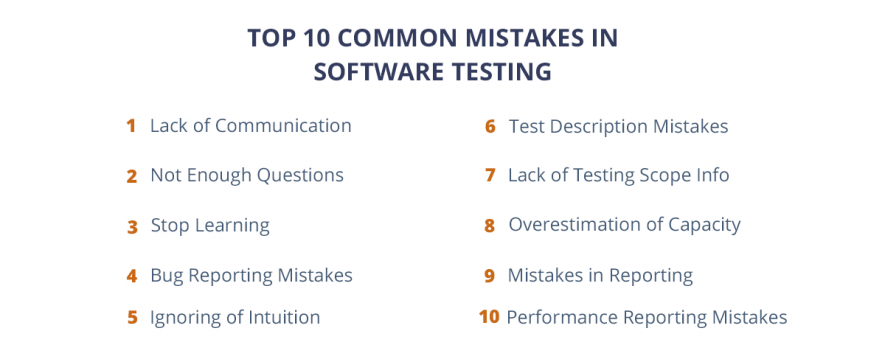- QATestLab Blog >
- QA for Business >
- Industries Insights >
- Top 10 Common Errors In Software Testing
As we know, one of the main tasks of testing is to find mistakes in the product. But what if a tester does mistakes in software testing? How to recognize and prevent these mistakes? How not to let the human factor reduce testing productivity? Forewarned is forearmed so that is why QATestLab shares the experience on the most common mistakes in testing for your review in the form of top 10 list.

Mistake 1 – Lack of Communication
Good communication is the basis for tester`s success. Tester has to communicate with Project Managers, developers, and product owners to learn the product thoroughly and perform his work well. To do this, a tester should look at the problem from different sides. It is important to communicate not only to gather information but also to analyze possible issues and their solutions. Communication is about asking questions, gathering, updating and sharing the information. Poor communication causes the failure of 30% of projects so that is why our specialists recommend Project Managers and Team Leads to provide and monitor the ability of testers to set up contacts, to get the necessary information for proper testing and give feedback, if required.
Mistake 2 – Overestimation of Capacity
Testers may think that it is possible to complete several tasks at once successfully but there are not many chances that it will work. It would be better to focus on each separate project and task, to divide the tasks to sub-tasks to be sure you keep with the schedule. When testers try to complete numerous tasks at the same time, it reduces the quality and effectiveness of testing. Our experience shows that it is important to specify the tasks of each tester and to dedicate strict time frames for each activity.
Mistake 3 – Not Enough Questions
When the tester has 10 years of experience, he may think that it is not necessary to clarify some facts or to ask something twice. This can be the reason for the failure of the entire project as the tester`s work may go in the wrong direction because he did not put the right question in time. Maybe it is not a problem of excessive self-confidence but of fear or misunderstanding. However, the more facts are clarified, the less is the probability of error. It is necessary to organize special meetings before and in the course of the project for clarification of relevant questions. This will exclude the misrepresentation of requirements and specifications.
Mistake 4 – Stop Learning
It would be a mistake to think that it is possible to reach the top of qualification and become an ideal tester, who does not need to learn anymore. It is unacceptable to stop obtaining and updating the knowledge in a sphere which changes and develops rapidly and permanently. You cannot assume that you know everything in the field where new inventions come every day so you have to use all available sources of relevant information which can help to perform the duties well. QATestLab, for example, has its own Training Center where our specialists pass the attestation every 6 months to increase the level of knowledge and qualification.
Mistake 5 – Ignoring of Intuitive Approach
One of the reasons why testers are still being involved in testing is that they are able to think critically and to foresee the most unpredictable situation. One of the irreplaceable traits is intuition. A tester can apply this tool relying on his experience and predict the issues before they become bugs. Unfortunately, testers use their intuition not so often due to the strict test plans and checklists, which defines the frames of testers responsibility and limits the freedom of actions. Specialists of QATestLab Training Center advice to follow the prescribed procedure but it would not be a mistake to check some additional elements, which are not obligatory to be tested just to reduce possible sources of defects.
Mistake 6 – Start of Testing without the Scope and Requirements
Successful completion of test tasks requires a well-structured plan which describes every action step by step. Each testing project must have its test plan which states what test to perform. The essential elements which must be defined first are the scope of testing and requirements to follow if you want to comply with the end result. A tester may rely on his experience and ignore the exact project specifications thinking that the current project is similar to the previous tasks, but it is unacceptable if you want to fulfill specific project requirements.
To avoid this mistake it is necessary to provide testers with a detailed description of the project aim, requirements and the expected result. Also, it is important to give all the available information about the product and its target consumers.
Mistake 7 – Mistakes in Test Performance Reporting
The reproduction steps should describe only those actions and their sequence that should lead to the reproduction of the bug, and allow to check its reproducibility after bug correction. You do not need to add extra information to the steps, such as the description of the nature of the defect in the last step. The last step is to pay attention to the place, block, page, etc., where the error is reproduced. This will help to quickly detect the defect, not opening a screenshot or video.
In addition, the steps often contain links to other pages on the site, which is not necessary. The page address is subjected to change. Instead of direct links, you need to add the names of the necessary pages and the steps that describe how to get to them, and in the first step – a link to the main domain of the website being tested.
Mistake 8 – Mistakes in Bug Reporting
The error report is the same part of documentation like any other and it should be framed competently. Spelling errors interfere with the perception of the essence of the bug described in the report. It is necessary to check the written text and follow the literacy of the presentation. To do this, you can use special online services for spell checking.
One bug report should describe only one error. You can not combine the description of two errors or write two different sentences in the subject. On the other hand, it is also not acceptable to duplicate bug reports: if the same error is repeated in different places or with different elements, this should be indicated in the additional information.
Mistake 9 – Mistakes in Test Description
Many people may find it difficult or unnecessary to follow the requirement for describing the test. Our testers use “What? Where?When?” rule. This principle helps to briefly and fully describe the essence of the error, where it occurs and under what conditions. It is a general rule, an algorithm for compiling a description of an error. Usually, the absence of any part (What ?, Where? Or When?) makes the description less informative.
Mistake 10 – No Additional Information
Very serious and frequent mistake. A bug can be reproduced only under certain conditions, such as a specific browser and its version, screen resolution, operating system, etc. To reproduce and correct an error, it is extremely important to know in which version of the browser, on which operating system, etc., a bug was found.
So Where is a Helping Hand?
There is no ideal process at all but you can always increase your chances to succeed. Software testing, like any other activity, is not for everyone but for people whose attentiveness detects the smallest details. But, if you decided that it is the field where you want to grow than it is great. As an independent testing provider with more than 12-years practice, we realize that experience can be obtained only through the years. We are glad to share our experience and hope that our practice and tips, in the most common mistakes too, will help you to reach the desired result in the shortest way.
Learn more from QATestLab
Related Posts:
About Article Author
view more articles
has one-year experience in blogging, technical writing, and copywriting.
View More Articles







No Comments Yet!
You can be the one to start a conversation.